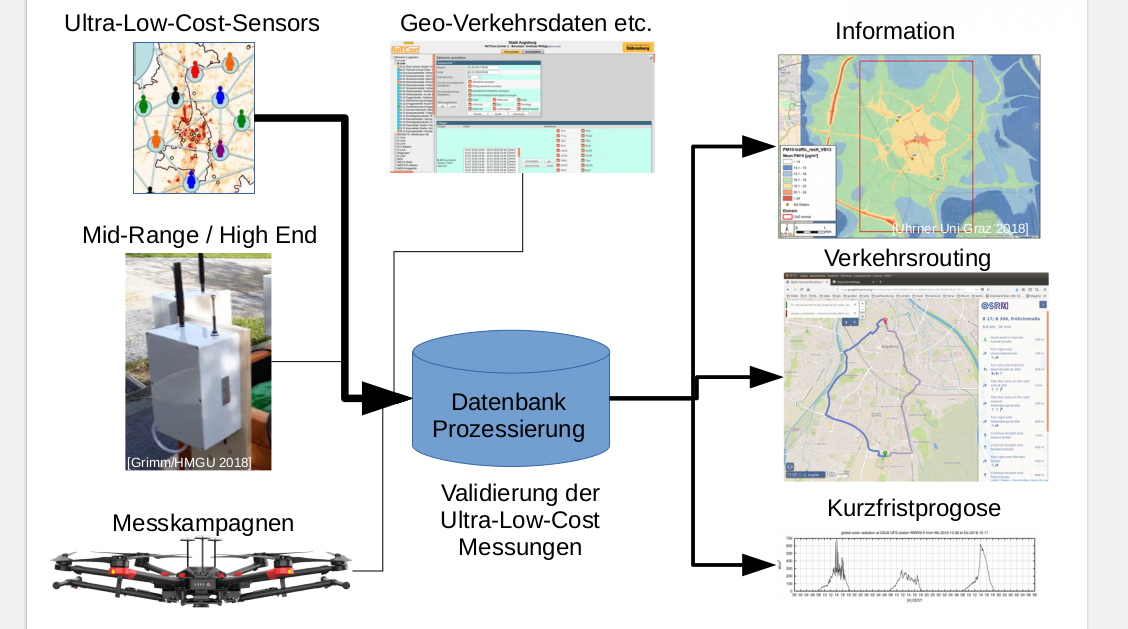Smart Air Quality Network
The Smart Air Quality Network project (SmartAQnet), researches and develops new ways of particulate matter data acquisitions at high spatial and temporal resolution. The aim of the project is to implement an intelligent, very high-resolution and yet cost-effective measuring network for air quality in the city of Augsburg. To ensure a high spatial coverage while maintaining high data quality, measurements are combined with low-cost sensors and reference devices distributed in the city.

Particulate Matter
Particulare matter (PM) are microscopic solid or liquid matter suspended in the atmosphere of earth. Term _aerosol _commonly refers to the particulate/air mixture, as opposed to the particulate matter alone. Sources of particulate matter can be natural anthropogenic. they have impacts on climate and precipitation that adversely affect human health. Depending on the particle size of the dust particles,particulate matter is subdivided into so-called fractions: PM10 includes all particles with aerodynamic diameter smaller than 10 micrometers (that is 10 milliosths of a meter) A subset of the PM10 fraction are the finer particles whose aerodynamic diameter is less than 2.5 microns. This is referred to as “fine fraction” or 2.5 (in contrast, the size range 2.5 to 10 microns “coarse fraction”).
Health Problem
The inhalation of the fine dust has a negative effect on the state of health. Small particles penetrate deeper into the airways than larger ones. They can not be excreted while exhaling. Ultrafine particles can also penetrate through the alveoli into the bloodstream and spred through the blood in the body. In the alveoli, the respiratory and circulatory systems are functionally and anatomically very closely linked. Therefore, disorders of one system - such as inflammatory changes in the respiratory tract - also affects the other system, like heart or circulation. The World Health Organization (WHO) has determined in studies that there is no fine dust concentration, below which no harmful effect is to be expected.
Measurement challenge
At present, particulate matter is determined gravimetrical at measurement stations. For this purpose, the air is sucked on filters, after a few days filters are collected, weighted and particulate matter concentration determined. Therefore one can only determine the PM concentration at an area after its occurance. Alsodaily variations of PM concentrations cannot be shown. Therefore one can only determine the PM concentration at an area after istsoccurance. Also daily variations of PM concentrations cannot be shown. Therefore optical methods enable measurement of particulate matter “in real time”, locally.
Currently there are too few measuring points that can capture fine dust throughout the country. Therefore there has been the citizen Science apprroach ffor several years. Using simple technologies, interested citizens can assemble their own PM-sensors, register the sensor and visualize the data on a map. Examples of suchprojects are luftdaten.info, hackAIR or OpenSenseMap. Disadvantage of these sensors is that they are not very accurate and that without measurements, a validation of the data quality is not possible. SmartAQnet therefore pursues the approach of combining the low-cost sensors with distributed reference dvices to obtain the necessary validation.
Come and join us for better scientific results
If you want to participate in the SmartAQnet project, want to build a sensor yourself and want to better understand environmental data, register with us! We are planning a workshop in Augsburg at the end of March. We will assemble sensors based on the model of Citizen Science project luftdaten.info (www.luftdaten.info), which you can then install at home. Register at: https://www.teco.edu/research%20/mitmachen-im-smart-air-quality-network-augsburg/